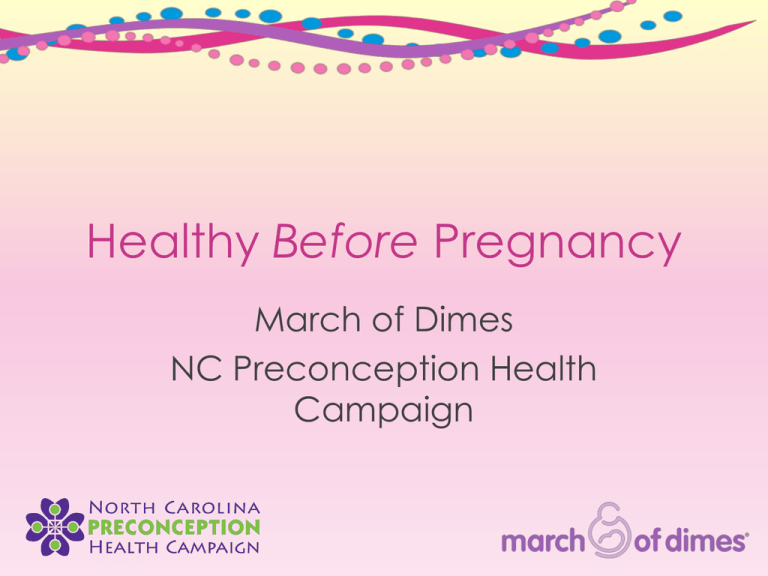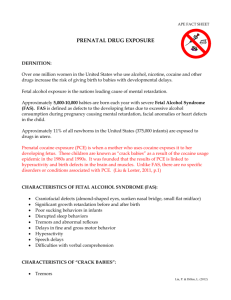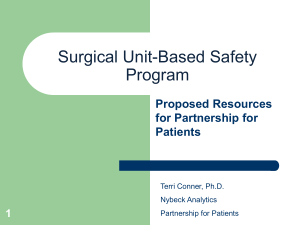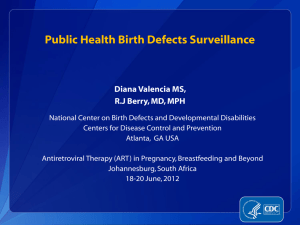
Healthy Before Pregnancy
March of Dimes
NC Preconception Health
Campaign
Pathways to poor birth outcomes:
Lesson Plan 1
Healthy before pregnancy
• Achieve a healthy
lifestyle BEFORE
becoming pregnant.
• Making healthy
choices before
pregnancy can
greatly improve birth
outcomes.
• A daily multivitamin,
eating smart and
moving more NOW
makes a big
difference.
Main messages
•
•
•
•
Make your life simple—take a multivitamin
Eat smart, move more
Know your risks, have a plan
Be a champion for healthy babies
Overview
• Section 1: Birth outcome terms
• Section 2: Causes of poor birth
outcomes
• Section 3: Overview of birth defects
• Section 4: NC and birth outcomes
• Section 5: What a healthy pregnancy
looks like
Section 1: Birth outcome terms
Birth outcome terms
•
•
•
•
•
•
•
•
Infant mortality
Birth defects
Unintended pregnancies
Environmental factors
Prenatal care
Premature birth (prematurity)
Epidemic
Low birthweight
Infant mortality
Birth defects
Unintended pregnancies
Environmental factors
Prenatal care
Premature birth (prematurity)
Epidemic
Preterm Births: US, 2007
Source: National Center for Health Statistics, final natality data. Retrieved September 29, 2010,
from marchofdimes.com/peristats. © 2010 March of Dimes Foundation. All rights reserved.
Epidemic
Preterm Births by race/ethnicity: North Carolina, 2005-2007 Average
Source: National Center for Health Statistics, final natality data. Retrieved September 29, 2010,
from marchofdimes.com/peristats. © 2010 March of Dimes Foundation. All rights reserved.
Low birthweight
=
Section 2: Causes of poor
birth outcomes
•
•
•
•
•
•
Genetic birth defects
Maternal illness
Medication
Environment (smoking, drugs, drinking)
Age of mother
“Don’t know” category
Genetic birth defects
Causes of poor birth
outcomes: Maternal illness
Medication
Environment
Age of mother
• Teen mothers are more likely to:
• Have babies born to soon and/or too
small
• Have babies that die
• Go into labor too early, have anemia and
high blood pressure
“Don’t know” category
Section 3: Overview of birth
defects
• 120,000 or 1 in 33
U.S. babies are
born with birth
defects
• Most common
include:
•
•
•
•
Heart defects
Cleft lip/palate
Down syndrome
Spina bifida
Single gene defects
•
•
•
•
Achondroplasia
Marfan syndrome
Tay-Sachs disease
Cystic fibrosis
X-linked birth defects
For example:
• Hemophilia
Birth defects: Chromosomal
For example:
• Down
syndrome
Down syndrome.
Source: U.S. Department of Energy Human Genome
Program.
Birth defects: Metabolic
disorders
For example:
Phenylketonuria
(PKU)
Copyright © March of Dimes Foundation, Inc.
Birth defects: Multifactorial
• Cleft lip/palate
• Neural tube
defects
• Heart defects
Source: Centers for Disease Control and Prevention,
National Center on Birth Defects and Developmental
Disabilities
Neural tube defects
• Spina bifida
• Anencephaly
Source: Centers for Disease Control and Prevention, National Center
on Birth Defects and Developmental Disabilities
Neural tube defects
• 2,500-3,000 U.S. babies are born each
year with NTDs
• Another 1,500 are still born or
terminated because of this birth
defect
• In NC, approximately 200 pregnancies
are affected by a NTD each year
Section 4: North Carolina and
birth outcomes
An average week in NC:
• How many babies are born?
2,459
An average week in NC:
• How many babies are born to teen
mothers (ages 15-19)?
283
An average week in NC:
• How many babies are born to mothers
who receive inadequate prenatal
care?
226
An average week in NC:
• How many babies are born
prematurely?
334
An average week in NC:
• How many babies are born low
birthweight (weighing less than 5 lbs,
8 oz)?
223
An average week in NC:
• How many babies die before their first
birthday?
21
How does NC compare?
• NC ranks 45th for
infant mortality
• NC ranks 41st for
premature birth
© 2009 March of Dimes Foundation. All rights
reserved.
Healthy birth outcomes
Main messages
•
•
•
•
Make your life simple - take a multivitamin
Eat smart, move more
Know your risks, have a plan
Be a healthy babies champion












